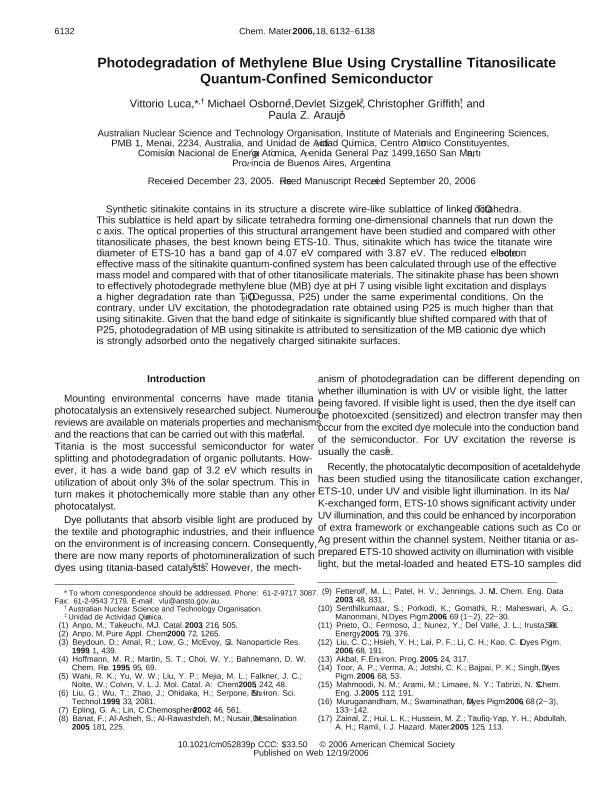Mostrar el registro sencillo del ítem
dc.contributor.author
Luca, Vittorio

dc.contributor.author
Osborne, Michael
dc.contributor.author
Sizgek, Devlet
dc.contributor.author
Griffith, Christopher
dc.contributor.author
Araujo, Paula Zulema

dc.date.available
2018-08-03T18:11:38Z
dc.date.issued
2006-12
dc.identifier.citation
Luca, Vittorio; Osborne, Michael; Sizgek, Devlet; Griffith, Christopher; Araujo, Paula Zulema; Photodegradation of methylene blue using crystalline titanosilicate quantum-confined semiconductor; American Chemical Society; Chemistry Of Materials; 18; 26; 12-2006; 6132-6138
dc.identifier.issn
0897-4756
dc.identifier.uri
http://hdl.handle.net/11336/54100
dc.description.abstract
Synthetic sitinakite contains in its structure a discrete wire-like sublattice of linked TiO6 octahedra. This sublattice is held apart by silicate tetrahedra forming one-dimensional channels that run down the c axis. The optical properties of this structural arrangement have been studied and compared with other titanosilicate phases, the best known being ETS-10. Thus, sitinakite which has twice the titanate wire diameter of ETS-10 has a band gap of 4.07 eV compared with 3.87 eV. The reduced electron-hole effective mass of the sitinakite quantum-confined system has been calculated through use of the effective mass model and compared with that of other titanosilicate materials. The sitinakite phase has been shown to effectively photodegrade methylene blue (MB) dye at pH 7 using visible light excitation and displays a higher degradation rate than TiO2 (Degussa, P25) under the same experimental conditions. On the contrary, under UV excitation, the photodegradation rate obtained using P25 is much higher than that using sitinakite. Given that the band edge of sitinkaite is significantly blue shifted compared with that of P25, photodegradation of MB using sitinakite is attributed to sensitization of the MB cationic dye which is strongly adsorbed onto the negatively charged sitinakite surfaces.
dc.format
application/pdf
dc.language.iso
eng
dc.publisher
American Chemical Society

dc.rights
info:eu-repo/semantics/openAccess
dc.rights.uri
https://creativecommons.org/licenses/by-nc-sa/2.5/ar/
dc.subject
X-Ray Absorption
dc.subject
Titanium Oxide
dc.subject
Photocatalysis
dc.subject
Ion-Exchange
dc.subject
Titosilicate
dc.subject.classification
Otras Ciencias Químicas

dc.subject.classification
Ciencias Químicas

dc.subject.classification
CIENCIAS NATURALES Y EXACTAS

dc.title
Photodegradation of methylene blue using crystalline titanosilicate quantum-confined semiconductor
dc.type
info:eu-repo/semantics/article
dc.type
info:ar-repo/semantics/artículo
dc.type
info:eu-repo/semantics/publishedVersion
dc.date.updated
2018-07-30T15:20:59Z
dc.journal.volume
18
dc.journal.number
26
dc.journal.pagination
6132-6138
dc.journal.pais
Estados Unidos

dc.journal.ciudad
Washington
dc.description.fil
Fil: Luca, Vittorio. Australian Nuclear Science and Technology Organisation; Australia
dc.description.fil
Fil: Osborne, Michael. Australian Nuclear Science and Technology Organisation; Australia
dc.description.fil
Fil: Sizgek, Devlet. Australian Nuclear Science and Technology Organisation; Australia
dc.description.fil
Fil: Griffith, Christopher. Australian Nuclear Science and Technology Organisation; Australia
dc.description.fil
Fil: Araujo, Paula Zulema. Comisión Nacional de Energía Atómica. Centro Atómico Constituyentes; Argentina. Consejo Nacional de Investigaciones Científicas y Técnicas; Argentina
dc.journal.title
Chemistry Of Materials

dc.relation.alternativeid
info:eu-repo/semantics/altIdentifier/url/http://pubs.acs.org/doi/abs/10.1021/cm052839p
dc.relation.alternativeid
info:eu-repo/semantics/altIdentifier/doi/http://dx.doi.org/10.1021/cm052839p
Archivos asociados
